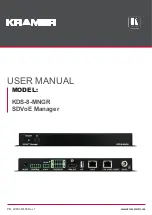
62
TERMINAL SERVERS
2. Connect the asynchronous device to the serial on which the listener
function has been defined (port 1 in the above example).
3. From any Telnet client that can reach the Terminal Server, open a Telnet
session with the Terminal Server. A typical command would be: telnet
CS_IP_address TCP_PORT
, where
CS_IP_address
is the IP address of
the Terminal Server and
TCP_PORT
is the TCP port defined in the Telnet
Listener command.
4. After the connection is established, any data from the attached device is
transmitted to the network and back.
5. The same is applicable for the parallel printer port but it is uni-
directional.
4.7 Configure LAT Services (Reverse LAT)
A LAT service may be defined in the Terminal Server to allow other LAT
hosts to create a session with the Terminal Server. The following applications
may necessitate reverse LAT services:
• Accessing the Terminal Server from another LAT node for management
purposes–A LAT service may be defined to allow access to the Terminal
Server itself. When a LAT session from any LAT node to the Terminal
Server is started, the same user interface is presented to the operator as if
he was accessing the server from a terminal connected directly to one of
its serial ports.
• Connecting printers to the Terminal Server in a LAT environment—
Terminal Server ports that are connected to printers should be
configured as a LAT service. Hosts that need to print will then start a
LAT session with the Terminal Server. Any combination of service names
together with the port they serve may be defined. More than one service
name can be defined and this name can then be used to access more than
one port.
• Communicating with serial devices from a LAT node—A LAT service can
be configured to connect other LAT nodes to any serial (RS-232) device.
In particular, the connecting LAT node can be another Terminal Server
that connects with a serial device and starts the LAT session on behalf of
these devices.
Содержание LE2101A-BT-R2
Страница 2: ......
















































